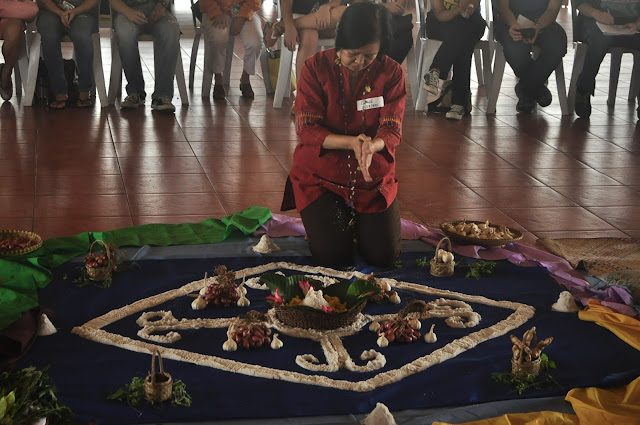By Rhea Claire Madarang
Imagine a babaylan come to life in these modern times and sharing her knowledge and wisdom to heal present-day health concerns like headaches and work-related stress, both physical and emotional.
This was what Girlie Villariba, contemporary babaylan healer and social psychologist, did last November 12, 2012 among over 65 teachers, students, and professionals, for the “Babaylan Bilang Manggagamot” (Babaylan as Healer) session of the Buhay Babaylan lecture-ritual series.
Villariba, who has created a healing modality she calls Body Talk, taught simple and quick practical body techniques applicable to various situations like starting one’s day, mentally preparing for a task by balancing the right and left brain for it, calming oneself emotionally, and healing oneself from common afflictions like diarrhea and ulcer.
Villariba included breathing, touch, tapping selected body parts with the fingers, and positive affirmations as part of the healing methods she shared.
She also emphasized these methods’ power and their backing by neuroscience. For instance, she included the temples as one of the body parts that needed to be tapped by the fingers as the temples, also known scientifically, as the pre-frontal cortex, are the “happiest part of the brain.”
She also talked about practices in some rural parts of the Philippines that are later proven by science, such as elders spitting on a baby’s skin to keep a baby healthy.
Villariba revealed that the saliva has 1,200 enzymes and many antibodies and showed how the saliva can be used for healing common illnesses and emotional tension.
“Every fluid of your body, like sweat or saliva, can help heal and balance your body,” she said.
Villariba also pointed out the importance of natural medicine through Philippine herbs, plants and spices. The turmeric (luyang dilaw), for example, can be used for colds, sore throats, and even to remove bad odors. The different spices and leaves from different medicinal plants Villariba mentioned were artfully arranged in a mandala on the floor for the Buhay Babaylan event.
Villariba said that even with all the healing techniques she taught, what was most important is the person’s mindset. “Your conscious effort to heal yourself is the best medicine. Your doctor cannot do it for you – no one can do it for you,” she said.
At the end of Villariba’s talk and demonstration, Leah Tolentino, director of Ginhawa, an NGO advocating well-being, spirituality and creativity, led a body-based ritual giving tribute to the four directions (North, South, East, West) through flowing body movements. Creative prayer ritual facilitator and social researcher, Dr. Erlinda Natocyad then led the audience into a simple ritual dance, with people moving in a circle around the mandala of leaves and spices in the middle of the room. In the lecture-ritual, singer-composers Shayne Merioles and Aireen Landicho sang Merioles’ Haplos ng Pag-Ibig, which means, touch of love.
The event, which was held at Ateneo de Manila University, Quezon City, is the third of the Buhay Babaylan lecture-ritual series. The first was the Babaylan Bilang Guro (Babaylan as Teacher) and the second was the Babaylan Sa Kasaysayan (Babaylan in History).
The first lecture-ritual of 2012 series is the DANCE OF THE SACRED FEMININE (Rediscovering the Babaylan and Mutya of the Contemporary World), March 10, 2012, 1 PM to be held at the Little Theater and Inner Garden of the University of the Philippines Manila, Padre Faura, Manila.



No comments:
Post a Comment